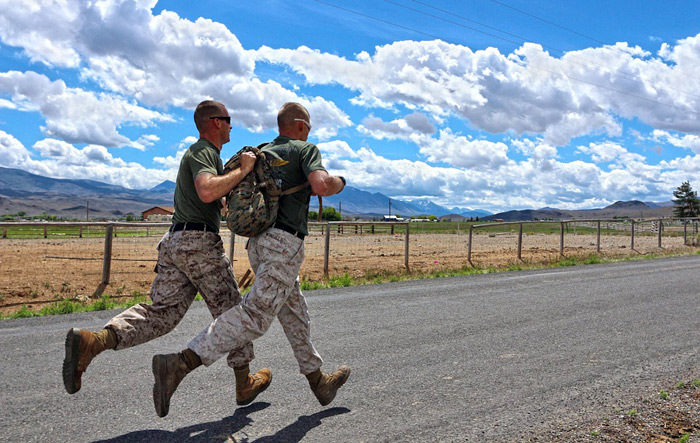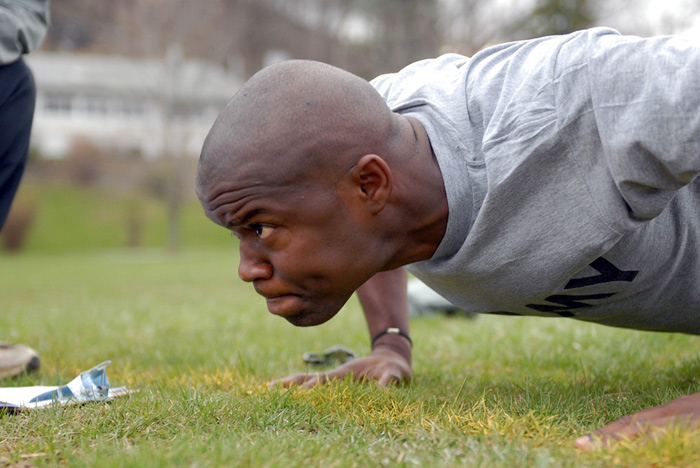The US Army requires new recruits and serving soldiers to undergo regular fitness assessments. Below is some information about the fitness requirements and standards. This information is presented for discussion and may change over time - for up-to-date information see official sources. See also the Candidate Fitness Assessment (CFA) used to assess candidates for the US Military Academy.
Occupational Physical Assessment Test
The Occupational Physical Assessment Test (OPAT) is a battery of four physical fitness test events that is used to assess the physical capabilities of new Army recruits.
The OPAT test events are:
- Standing long jump — jump for distance
- Seated power throw — with the back against a wall, throw a 2kg medicine ball as far as possible
- Strength deadlift — a test of lower body strength
- Interval aerobic run — the shuttle run "beep test" for aerobic fitness
 US Army soldiers in training
US Army soldiers in trainingArmy Combat Fitness Test
The Army Combat Fitness Test (ACFT) - previously called the Army Combat Readiness Test - is a newly designed fitness testing protocol that more closely replicates the types of physical actions that army personel do on the battlefield. All Soldiers will be required to take the new gender and age-neutral test starting in October 2020. The scoring system has not yet been finalized, but is expected to be a gender and age neutral scoring system, with 100-points available for each of the six events, with a 60-point minimum standard.
The only test component from the previous testing protocol that has remained is the 2-mile run. For the current test details, see the Army Physical Fitness Test described further down this page.
The 6 Tests of the ACFT
- 2-Mile Run: run 2 miles (3.22km) as fast as possible.
- 250-meter sprint/drag/carry: Soldier begins in the prone position, stands up and sprints 25 meters to the far line, returns to the start line, pulls sled backwards to the far line, returns backwards with sled to the start line, grasps two 30-pound kettlebells and runs 25 meters to the far line, returns with the kettlebells to the start line, drops kettlebells at start line, turns and sprints 25 meters to the far line, and returns to the start/finish line.
- Max Weight Deadlift: a 3-repetition max test of lower body strength, using the deadlift exercise.
- Leg Tuck: grasp a climbing bar with alternating grip in the dead hang position; flex with elbows, hips and knees to bring knees up and touch the elbows to the knees; then return to the dead hang position. Repeat as many times as possible.
- Standing Power Throw: the soldier tosses a 10-pound medicine ball backwards over their head for maximum distance.
- Hand Release Push-up: the soldier begins in the down position, pushes body into up position, lowers body to ground, momentarily lifts the hands off the ground, and then returns to the starting position.
 the push-up test was in the old army testing protocol
the push-up test was in the old army testing protocolThe Army Physical Fitness Test (soon to be outdated)
The APFT is designed to test muscular strength/endurance and cardiovascular respiratory fitness of soldiers in the US Army. Army personnel are required to perform the APFT every 6 months, unless there is an injury or other reason they cannot partake in their testing. The APFT ensures that they are keeping themselves physically fit and in a state of physical readiness.
There are three tests that make up the testing battery for the APFT:
- Sit up (number in 2 minutes)
- Push-up (number in 2 minutes)
- 2-mile run (fastest time)
Alternatives
If a soldier has a permanent medical condition that keeps them from conducting the 2-mile run, an alternate event (2.5-mile walk, 800-yd swim, or 6.2-mile bike) is taken. There is no alternative for the other two tests.
Assessment
The soldiers are given a score based on their performance in the three test. The scoring scale is based on sex, age and performance for the event. The scores normally range from 0 to 300. In order to pass the APFT, a total score for the three events of 180 or higher is required, with a minimum score of 60 in each event. Soldiers who score 270 or above, with a minimum score of 90 in each event, are awarded the Physical Fitness Badge, which can be worn on the PT uniform. The APFT score also converts to promotion points which are used to determine the eligibility of soldiers for promotion to the ranks of Sergeants and Staff Sergeants.
Failure to pass consecutive APFTs can ultimately lead to discharge from the US Army, though not always. They may be put into a remedial program of extra PT sessions.
More Information
For the most up to date information, you should consult the Army Field Manual FM 21-20, which covers all the details about the administering of the APFT.
Disclaimer
The workplace assessment tests listed here are believed to be accurate at the time it was accessed. Testing protocols and standards are often changed. Please see official sources for accurate up to date information. If you have corrections please contact me or use the comments form below.
Related Pages
- Army Fitness Testing around the world
- Testing in other armed forces and similar services
- Poll: Should women have the same fitness testing standards as men?
- Descriptions of the three APFT test procedures: sit up, push-up and 2-mile run.
- About the US defence force tape test
- Videos of forces fitness testing


 Current Events
Current Events